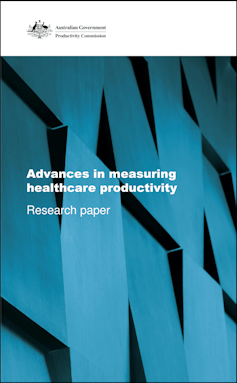Yes, spending on health is growing, but new research shows we’re getting more for it
- Written by John Goss, Adjunct Associate Professor, Health Research Institute, University of Canberra

Government spending on health has been growing so rapidly that a decade ago the then health minister Peter Dutton called it “unmanageable[1]” and “unsustainable[2]”.
Health spending grew in real terms by 44% in the ten years to 2021–22. Real GDP grew by 26% in that period, so we have been spending increasing amounts on health as a proportion of GDP.
Until recently, we had little idea of whether that extra spending was value for money – whether it was making Australians healthier, and whether each dollar was making Australians more healthy over time.
In other words, we have had very little idea of the productivity of the healthcare system. The Bureau of Statistics doesn’t measure it[3] in the national accounts.
As with defence, we have only ever known what we have spent on health, without necessarily knowing what we actually get for this money, and whether our value for money is improving or not.
Health productivity has been a mystery until now
Piecemeal attempts to get a better handle on the productivity of healthcare services have defined their outputs as the number of medical or hospital services delivered or pharmaceuticals delivered for each dollar spent. These attempts have shown only small increases in productivity.
But the problem with these estimates is they haven’t measured the outputs that matter, which are greater health-related quality of life and longer lives that result from health treatments.
Now, for the first time, the Productivity Commission has attempted to measure what actually matters. And what it’s come up with is startling[4].
The commission has found that between 2011-12 and 2017-18, at a time when the market-sector productivity growth for the economy as a whole grew by 0.7% per year, the productivity of the healthcare sectors it examined grew by 3% per year[5].
The sectors the commission was able to examine were those that treat cancer, cardiovascular disease and “blood, endocrine and kidney disease”.
The commission says its findings suggest:
[…] the additional spending in the parts of the healthcare sector we studied has been ‘worth it’ – it has delivered net benefits for society.
But its finding of average growth of about 3% per year conceals marked differences in productivity growth by disease.
For cancer treatment, the productivity growth has been about 9% per year, much more than economy-wide productivity growth. But for treating cardiovascular disease, productivity has shrunk by about 4% per year.
Cancer treatments work better
The large improvement in the productivity of cancer treatment is not surprising. Cancer survival rates continue to improve, from a five-year survival rate of 52% in the early 1990s to 70%[6] in 2014-2018.
It’s an improvement more than big enough to offset the relatively high growth in real cancer expenditure of 36% over the period studied.
More surprising is the decline in the productivity of cardiovascular treatment.
Partly this is because a good deal of the decline in cardiovascular premature mortality rates of 21%[7] in the period studied has been due to things other than health treatment expenditure, reduced smoking among them.
Remaining heart attacks might be harder to treat
As well, our successes in preventing cardiovascular disease in recent decades may be making the treatment of those who succumb to it more difficult.
Fewer people suffering heart attacks and strokes might mean the remaining cases admitted to hospitals are more complex and more expensive to treat, reducing the apparent productivity of treatment.
It is also possible that there are data errors in the productivity estimates. And it is likely some cardiovascular disease treatments are cost-effective and others are not, making the mix of treatments push down overall productivity.
The commission quite rightly calls for more research and better data to find out.
Difficult decisions ahead
The commission has examined only about one-third of health treatments.
The remaining two-thirds include important diseases like mental illness, dementia, infectious diseases and musculoskeletal disorders.
The commission has done some work on mental illness[8]. It determined that outcomes would be improved if resources were shifted from hospital treatment to cost-effective treatments in the community and improving things such as inadequate incomes, employment, housing, social support and justice services.
As the commission does more, it will also need to assess the productivity of interventions that prevent diseases, as well as interventions that treat them.

















